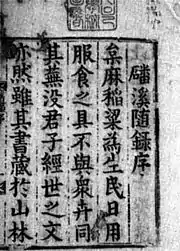Yu Hyeong-won
Yu Hyeong-won (Korean: 유형원; 1622–1673), also spelled as Yoo Hyung-Won, was a Korean philosopher. His art name was Ban'gye (磻溪). He was a Neo-Confucianist and science scholar of the Korean Joseon Dynasty. He was Korean pioneer of the early silhak ("practical learning") school[1][2] as well as a social critic and scholar of the late Joseon period. He was the disciple of Misu Heo Mok and second cousin of the silhak scholar Seongho Yi Ik.
| Korean name | |
| Hangul | 유형원 |
|---|---|
| Hanja | 柳馨遠 |
| Revised Romanization | Yu Hyeongwon |
| McCune–Reischauer | Yu Hyǒngwǒn |
| Art name | |
| Hangul | 반계 |
| Hanja | |
| Revised Romanization | Ban'gye |
| McCune–Reischauer | Pan'gye |

Yu was a member of the Munhwa Yu clan, and many of his extended family members held high official positions in the Joseon government.[3][4] However, he did not become an official, but led the life of a reclusive scholar. His work, Bangyesurok, became influential during the reign of King Yeongjo, who was made aware of it in 1741 and authorised its printing in 1770.[5]
Works
- Bangyesurock(반계수록 磻溪隧錄)
- Bangyejip(반계집 磻溪集)
- Baekgyungsajam(백경사잠 百警四箴)
- Bangyeilgo(반계일고 磻溪一顧)
- Gunhyunje(군현제 郡縣制)
- Yigichongron(이기총론 理氣總論)
- Nanhakmulli(논학물리 論學物理)
- Gyungsulmundap(경설문답 經說問答)
- Jujachanyo(주자찬요 朱子纂要)
- Yeojiji(여지지 輿地志)
- Gunhyunjije(군현지제 郡縣之制)
- Gihaengilrok(기행일록 紀行日錄)
- Dongguksaksagangmokjorye(동국사강목조례 東國史綱目條例)
- Donggukyuksagibo(동국역사가고 東國歷史可考)
- Sokgangmokuibo(속강목의보 續綱目疑補)
- Dongsaguiseolbyun(동사괴설변 東史怪說辨)
- Mugyungsaseocho(무경사서초 武經四書抄)
- Gihyosinseojulhyo(기효신서절요 紀效新書節要)
- Chungeumjinam(정음지남 正音指南)
- Dojeongchuljip(도정절집 陶靖節集)
- Donggukmuncho(동국문초 東國文抄)
- Jungweowirack(중여위략 中與偉略)
See also
- Yi Sugwang
- Yu Suwon
- Heo Mok
- Yun Hyu
- Yi Seou
- Yi Ik
- Jeong Yakyong
References
- Kang, Jae-eun, (2006), p. 376
- Silhak Encyclopædia Britannica
- 유형원 柳馨遠 [Yu Hyeongwon] (in Korean). Nate / Encyclopedia of Korean Culture.
- 유형원 柳馨遠 [Yu Hyeongwon] (in Korean). Nate / Britannica.
- James B. de Palais (1 May 2014), Confucian Statecraft and Korean Institutions: Yu Hyongwon and the late Chosun dynasty, p. 9, Wikidata Q120064723
Kang, Jae-eun; Lee, Suzanne. (2006) "The land of scholars: two thousand years of Korean Confucianism", Homa & Sekey Books, ISBN 1-931907-37-4